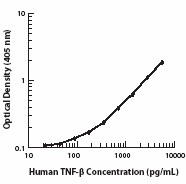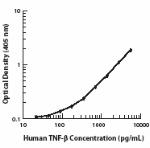- Clone
- 359-238-8 (See other available formats)
- Regulatory Status
- RUO
- Other Names
- Lymphotoxin-α (LT- α), Tumor necrosis factor-β (TNF-β), Coley's toxin, Hemorrhagic factor, Necrosin, Natural killer cytotoxic factor (NKCF), Differentiation inducing factor (DIF), TNFSF-1
- Isotype
- Mouse IgG1, κ

| Cat # | Size | Price | Quantity Check Availability | ||
|---|---|---|---|---|---|
| 503002 | 500 µg | $235.00 | |||
Lymphotoxin-α (LT-α), also known as tumor necrosis factor-beta (TNF-β), is a potent lymphoid factor that exerts cytotoxic effects on a wide range of tumor cells and certain other target cells. LT-α possesses a signal peptide sequence and is a secreted protein; however, LT-α is also present on the surface of activated T, B and LAK cells as a complex with LT-β. Bioactive LT-α exists as a homotrimer.
Product Details
- Verified Reactivity
- Human
- Antibody Type
- Monoclonal
- Host Species
- Mouse
- Immunogen
- E.coli expressed, recombinant human LT-α.
- Formulation
- Phosphate-buffered solution, pH 7.2, containing 0.09% sodium azide.
- Preparation
- The antibody was purified by affinity chromatography.
- Concentration
- 0.5 mg/ml
- Storage & Handling
- The antibody solution should be stored undiluted between 2°C and 8°C.
- Application
-
ELISA Capture - Quality tested
- Recommended Usage
-
Each lot of this antibody is quality control tested by ELISA assay. For ELISA capture applications, a concentration range of 1-4 µg/ml is recommended. It is recommended that the reagent be titrated for optimal performance for each application.
- Application Notes
-
ELISA or ELISPOT Capture1,2: The purified 359-238-8 antibody is useful as the capture antibody in a sandwich ELISA or ELISPOT assay, when used in conjunction with the biotinylated 359-81-11 antibody (Cat. No. 503104) as the detecting antibody. The LEAF™ purified antibody is suggested for ELISPOT capture.
Neutralization1,2: The 359-238-8 antibody can neutralize the bioactivity of human LT-α. The LEAF™ purified antibody (Endotoxin <0.1 EU/μg, Azide-Free, 0.2 μm filtered) is recommended for neutralization of human LT-α bioactivity (Cat. No. 503004). -
Application References
(PubMed link indicates BioLegend citation) -
- Meager A, et al. 1987. J. Immunol. Methods 104:31.
- Meager A, et al. 1987. Hybridoma. 6:305.
- Product Citations
-
- RRID
-
AB_315268 (BioLegend Cat. No. 503002)
Antigen Details
- Structure
- TNF superfamily; trimer; 25 kD (Mammalian)
- Bioactivity
- Transformed cell cytotoxicity; mediator of inflammatory and immune functions; fibroblast synthesis of GM-CSF, G-CSF, IL-1, collagenase, prostaglandin E2; monocyte terminal differentiation, synthesis of G-CSF; neutrophil chemoattractant, production of reac
- Cell Sources
- Activated T and B cells, fibroblasts, astrocytes, myeloma, endothelial cells, epithelial cells
- Cell Targets
- Monocytes, B cells, fibroblasts, neutrophils, osteoclasts, keratinocytes, endothelial cells
- Receptors
- TNFRSF1A (TNF-R1, CD120a, TNFR-p60 Type β, p55); TNFRSF1B (TNF-R2, CD120b, TNFR-p80 Type A, p75)
- Biology Area
- Cell Biology, Immunology, Innate Immunity, Neuroinflammation, Neuroscience
- Molecular Family
- Cytokines/Chemokines
- Antigen References
-
1. Fitzgerald K, et al. Eds. 2001. The Cytokine FactsBook. Academic Press, San Diego.
2. Aggarwal B, et al. Eds. 1992. Tumor necrosis factors:structure, function, and mechanism of action. Marcel Dekker Inc.
3. Bonavida B, et al. Eds. 1990. Tumor necrosis factor:structure, mechanisms of action, role in disease and therapy. Karger, Basel.
4. Paul N, et al. 1987. Annu. Rev. Immunol. 6:407. - Regulation
- Type II integral membrane protein, forms heterotrimer with type II integral membrane protein LT-β either as LTα1β2 or LTα2β1; processed secreted form is trimeric
- Gene ID
- 4049 View all products for this Gene ID
- UniProt
- View information about LT-alpha on UniProt.org
Other Formats
View All LT-α Reagents Request Custom Conjugation| Description | Clone | Applications |
|---|---|---|
| Purified anti-human LT-α (TNF-β) | 359-238-8 | ELISA Capture |
Compare Data Across All Formats
This data display is provided for general comparisons between formats.
Your actual data may vary due to variations in samples, target cells, instruments and their settings, staining conditions, and other factors.
If you need assistance with selecting the best format contact our expert technical support team.


